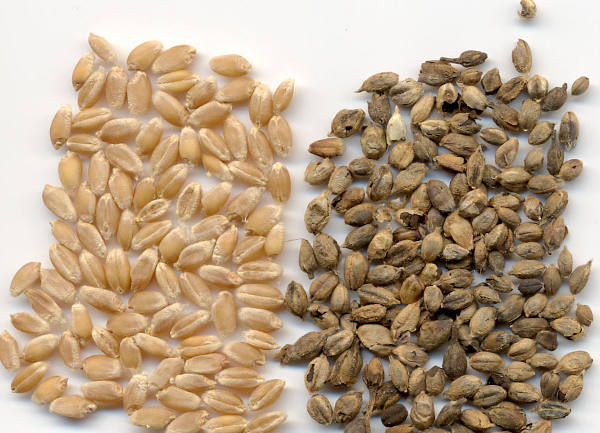June 13, 2011

Oklahoma Cooperative Extension Service offices have received reports about the presence of common bunt – also known as stinking smut – in wheat harvested in Roger Mills, Washita and Custer counties.
“In at least one of these cases, the load was rejected by the elevator and the grower was told not to return with similar wheat,” said Mark Gregory, Oklahoma State University Cooperative Extension area agronomy specialist for the region.
It may seem like “piling on” to wheat growers who have already faced a number of damaging factors this year: longstanding drought conditions, untimely freezes followed by excessive heat and strong sustained winds.
Bunts and smuts are caused by fungi that affect the seed of wheat and other small grains and grasses. The two that occur in Oklahoma are loose smut and common bunt.
“Common bunt is evident before harvest when developing seeds in infected heads reveal seeds that are filled with black spores with an associated rotted, musty odor, giving the bunt its other widely used name of stinking smut,” said Bob Hunger, OSU Cooperative Extension wheat pathologist.
During harvest, these bunted kernels – often called “bunt balls” – usually break and the spores are disbursed onto healthy grain and into the soil. When this infested grain is planted the next fall, either spores on the grain or spores in the soil germinate and infect the young seedling. The fungus then grows with the plant and bunted or smutty heads are produced instead of healthy heads.
“Loose smut is evident in wheat at heading when infected heads show masses of powdery black spores instead of developing kernels,” Hunger said. “Spores of loose smut have no odor and are usually gone by harvest time.”
Wind spreads the spores to healthy heads where they infect developing wheat kernels and then lie dormant until that seed is planted in the fall. The loose smut fungus then infects that seedling and grows with the plant, producing loose-smutted heads.
Loose smut and common bunt are readily controlled by planting seed wheat treated with a fungicide that is active against the bunts/smuts.
“Nearly all current seed treatments contain a fungicide that is systemic, that is they contain a chemical that moves into the germinating seedling and will kill the fungus inside the seedling,” Gregory said.
Some treatments also may contain a contact chemical, which does not move into the germinating seedling but rather stays on the outer surface.
“Always make sure that the seed treatment used is composed of a systemic fungicide or a systemic plus a contact fungicide,” Gregory said. “This is especially critical with loose smut because this fungus already is located inside the kernels rather than on the surface or in the soil as with common bunt.”
Many of the current seed treatments also will offer early season protection against other seedling diseases as well as against insect pests such as aphids.
In summary, Gregory and Hunger recommend that a wheat producer’s checklist in selecting a seed treatment ensure the following:
● Be certain that a compound with activity against common bunt and loose smut is included;
● Be sure that seed is thoroughly treated at the recommended rate; and
● Always read and follow all directions on the product label.
A complete listing of seed treatments registered for control of bunts and smuts is available in the most recent edition of the OSU Extension Agents’ Handbook of Insect, Plant Disease and Weed Control, accessible through all OSU Cooperative Extension county offices.
You May Also Like




